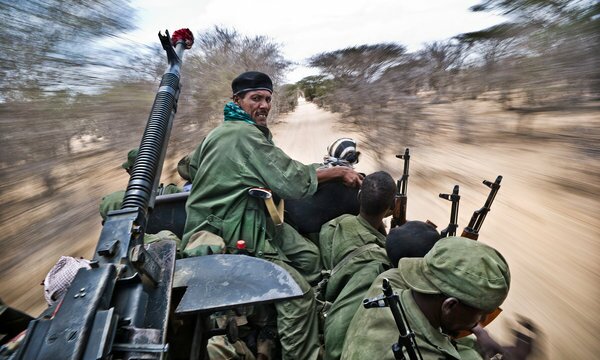As an Enemy Retreats, Clans Carve Up Somalia
 DHOBLEY, Somalia — Adan Dahir Hassan sits in a bald office, wires dangling from the ceiling, handing out death sentences. Recently installed by an Islamist warlord, Mr. Hassan recalled how he had ordered a soldier who had killed a civilian, possibly by accident, to be delivered to the victim’s family, which promptly shot him in the head
DHOBLEY, Somalia — Adan Dahir Hassan sits in a bald office, wires dangling from the ceiling, handing out death sentences. Recently installed by an Islamist warlord, Mr. Hassan recalled how he had ordered a soldier who had killed a civilian, possibly by accident, to be delivered to the victim’s family, which promptly shot him in the head
“It’s Islamic law,” said Mr. Hassan, the professed district commissioner of this bullet-riddled town. “That’s what makes the community feel happy.”
For the first time in years, the ShababIslamist group that has long tormented Somalis is receding from several areas at once, including this one, handing the Transitional Federal Government an enormous opportunity to finally step outside the capital and begin uniting this fractious country after two decades of war.
Instead, a messy, violent, clannish scramble is emerging over who will take control.
This is exactly what the United States and other donors had hoped to avoid by investing millions of dollars in the transitional government, viewing it as the best antidote to Somalia’s chronic instability and a bulwark against Islamic extremism.
But the government is too weak, corrupt, divided and disorganized to mount a claim beyond Mogadishu, the capital, leaving clan warlords, Islamist militias and proxy forces armed by foreign governments to battle it out for the regions the Shabab are losing.
Already, clashes have erupted between the anti-Shabab forces fighting for the spoils, and roadblocks operated by clan militias have resurfaced on the streets of Mogadishu, even though the government says it is in control. Many analysts say both the Shabab and the government are splintering and predict that the warfare will only increase, complicating the response to Somalia’s widening famine.
“What you now have is a free-for-all contest in which clans are unilaterally carving up the country into unviable clan enclaves and cantons,” said Rashid Abdi, an analyst for the International Crisis Group, which studies conflicts. “The way things are going, the risk of future interregional wars and instability is real,” Mr. Abdi added, “even after Al Shabab is defeated.”
More than 20 separate new ministates, including one for a drought-stricken area incongruously named Greenland, have sprouted up across Somalia, some little more than Web sites or so-called briefcase governments, others heavily armed, all eager for international recognition and the money that may come with it.
Officials with the 9,000-strong African Union peacekeeping force, the backbone of security in Mogadishu, say they are deeply concerned by this fragmentation, reminiscent of Somalia’s warlord days after the government collapsed in 1991.
“What was holding everybody together is now gone,” lamented an African Union official, who asked not to be identified because he was departing from the official line that all is well in Mogadishu. “All these people who came together to fight the Shabab are now starting to fight each other. We weren’t prepared for this. It’s happening too fast.”
American officials are struggling to keep up with Somalia’s rapidly evolving — or some say devolving — politics, saying they have lost faith in the transitional government’s leaders and are now open to the idea of financing some local security forces, part of what they call a “dual track” approach to supporting the national and local governments at the same time.
“It wouldn’t be the worst thing in the world to have a local leader with some charisma and grass-roots support,” said one American official, who was not authorized to speak publicly.
Perhaps no area better illustrates the creeping warlordism than Dhobley, a forlorn little town near the Kenyan border contested by two new militias, one led by a dapper, French-educated intellectual, the other by an Islamist sheik who used to be in league with the Shabab.
People are starving here, victims of Somalia’s famine, 70-pound adults and tiny babies with skin cracked like old paint. But there are few aid organizations around. They have been scared off by the hundreds of undisciplined militiamen, who constantly fire off their guns and have killed each other in recent weeks.
The gunmen in solid green fatigues belong to Ahmed Madobe, the Islamist sheik-turned-warlord who just a few years ago was hunted down by American forces, wounded by shrapnel during an air raid and then spirited away to an Ethiopian prison.
“I wasn’t just in the Shabab; I helped found it,” Sheik Madobe boasted the other day, as he sat in a tent on Dhobley’s outskirts, flanked by dozens of baby-faced fighters. He said he had quit the Shabab because “they’re killers,” though several analysts said it was a more prosaic breakup over smuggling fees.
Also prowling around Dhobley, between crumbling buildings and stinking piles of animal carcasses from the drought, are hundreds of gunmen in camouflage fighting for another man, known as the Professor.
Mohamed Abdi Mohamed, better known as Professor Gandhi, is a former university lecturer who says he holds two French Ph.D.’s — in geology and anthropology. He has formed his own state, Azania, complete with two houses of representatives and special seats for women, though he is not actually in Dhobley and seems to spend a lot of time in Kenya.
“Let’s just say Madobe and I have different values,” Professor Gandhi said from the tearoom of a fancy hotel in Nairobi, the Kenyan capital, where he was wearing gold-rimmed glasses and a stylish thick cotton blazer.
Professor Gandhi’s and Sheik Madobe’s forces, working simultaneously though not quite together, recently pushed the Shabab out of a few towns along the Kenyan border. The Kenyan military has been backing them up, and according to American diplomatic cables, the Chinese government gave Kenya weapons and uniforms for the Somali militiamen, possibly because there is oil in southern Somalia that the Chinese covet.
A similar situation is unfolding near the Ethiopian border, where an Ethiopian-backed militia has defeated Shabab forces and established a narrow zone of control. In central Somalia, another militia, Ahlu Sunna Wal Jama’a, which also receives Ethiopian weapons, has seized several towns from the Shabab as well.
The Shabab seem to be undercut by internal fissures, though they still have thousands of fighters. Several leaders, including Fazul Abdullah Mohammed, have recently been killed, and the Shabab’s policy of blocking Western food aid at a time of famine has meant that hundreds of thousands of people have fled their territory, depleting the militants’ resources and depriving them of recruits. Those who remain are often too poor to tax or too sick to soldier.
In August, the Shabab announced they were pulling out of Mogadishu for the first time in years, though some fighters apparently stayed behind to terrorize the population and behead more than a dozen people.
The new anti-Shabab forces have differing relationships with the transitional government. Sheik Madobe says he is willing to work with transitional leaders; Professor Gandhi dismissed them as a lost cause. But even the local administrations marginally aligned with the government say they do not get much help from Mogadishu and now want to break away.
“Separation, that’s our dream,” said Abdirashid Hassan Abdinur, a local official in Dolo, near the Ethiopian border. As for a name, he said they were still working on that. “All I can say is that we’ll pick it here, not at some foreign hotel.”
Source: NY Times
Comments
comments
 Calendar
Calendar






































